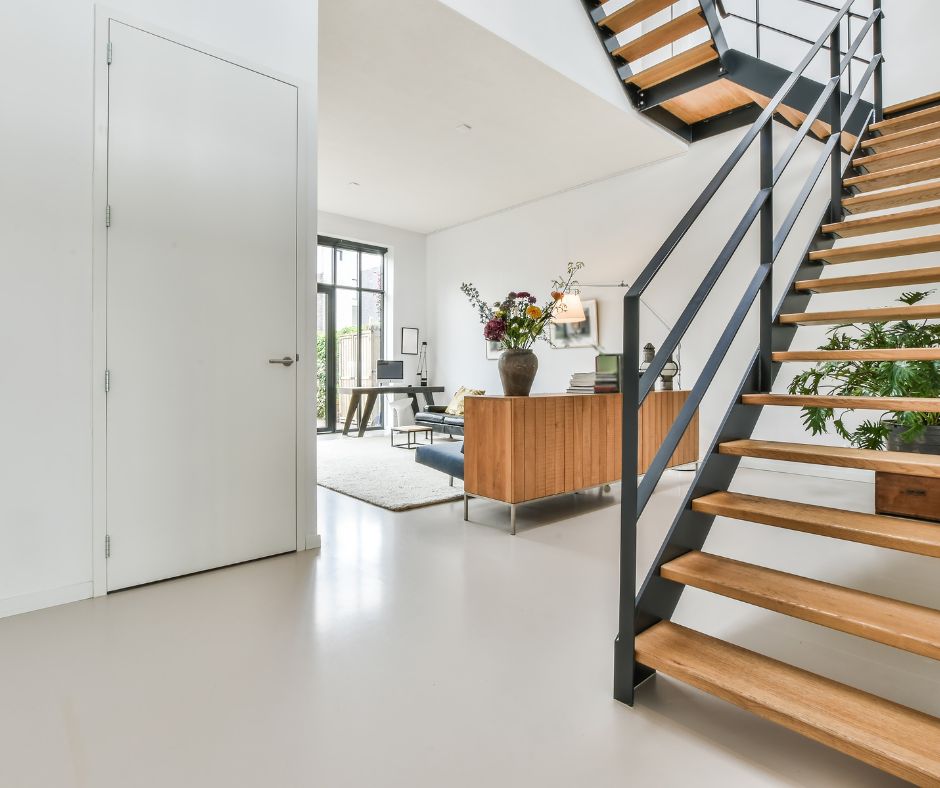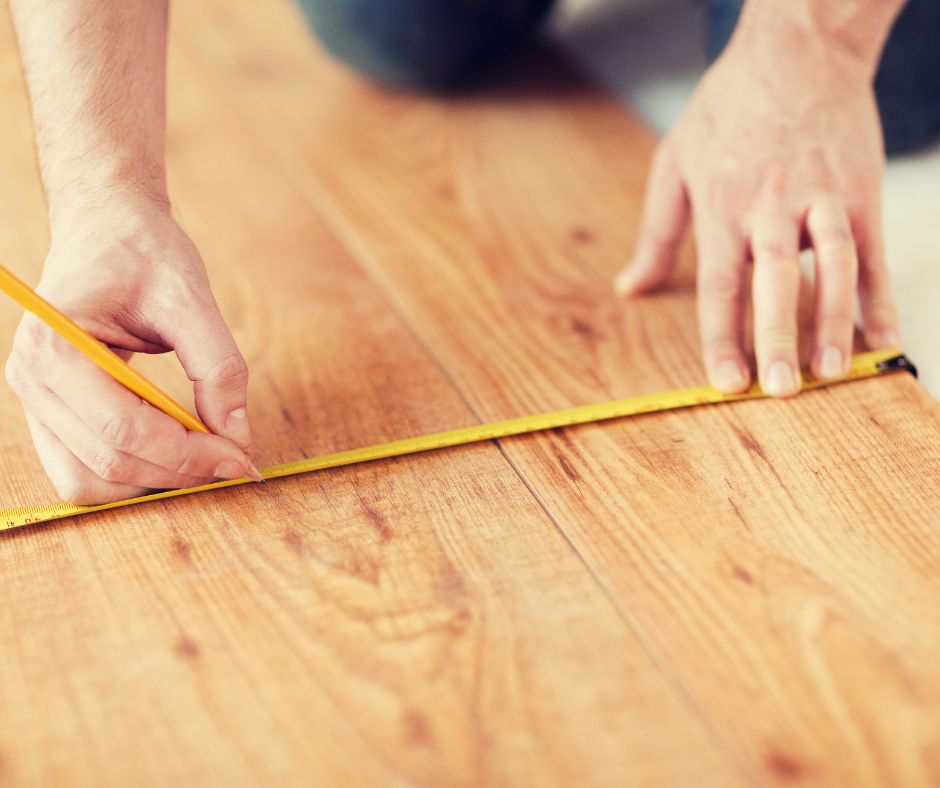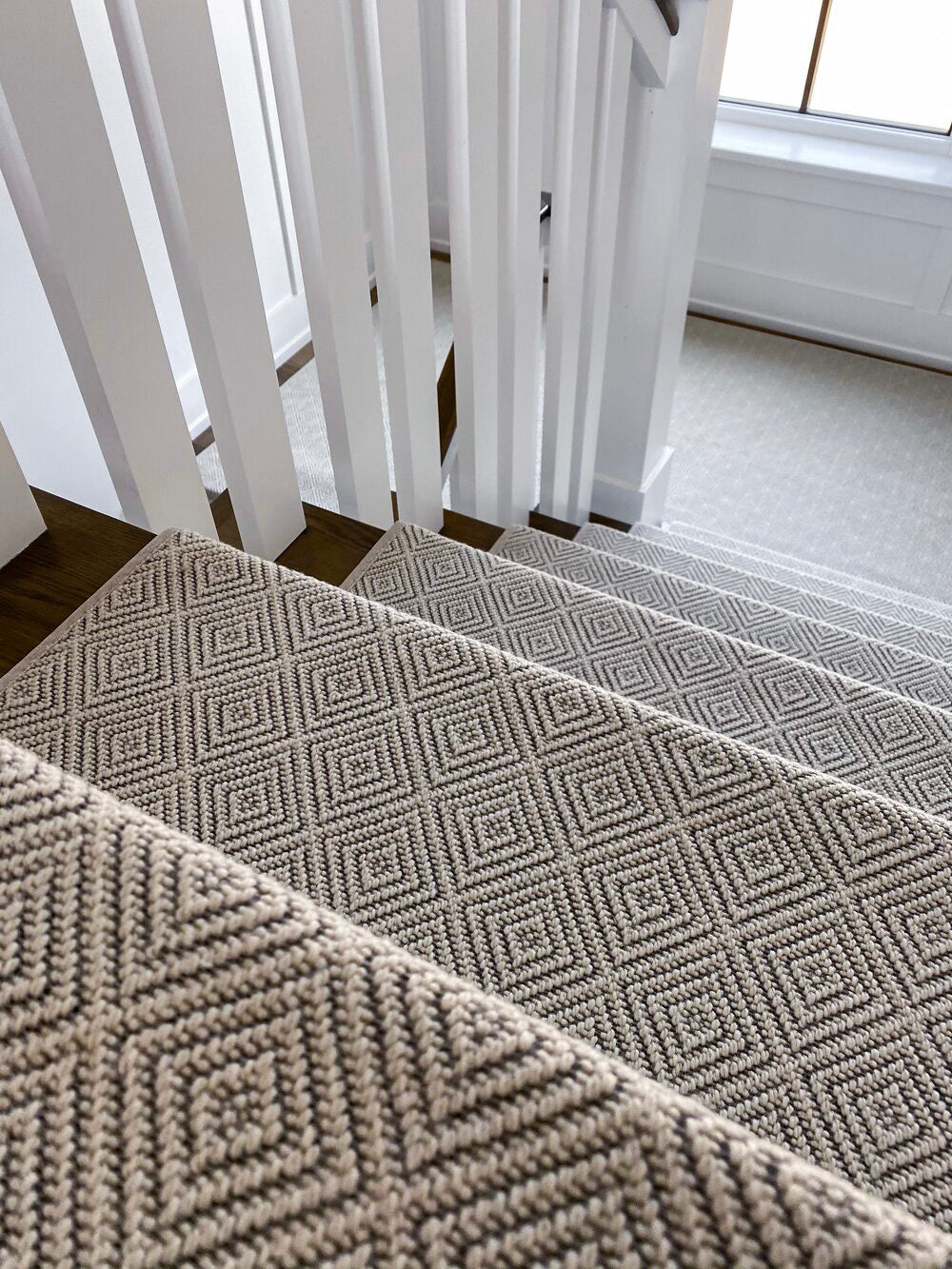Planning a staircase that’s both functional and beautiful can feel overwhelming—especially when space is tight. The best plans for designing a quarter-turn staircase include choosing the correct direction of the turn, measuring accurate rise and run dimensions, and deciding between a landing or winder steps. Pairing that layout with carpet stair treads adds comfort and safety without the need for permanent materials.
In this guide, you'll learn how to design a staircase that fits your home, meets code, and complements your interior style. We’ll cover orientation, space-saving tips, dimensions, and smart material choices that elevate your stair design. Keep reading to simplify your planning process and get expert-backed insight every step of the way.
Understanding Quarter-Turn Staircases
Quarter-turn staircases are designed to shift direction mid-way, allowing homeowners to tuck a staircase into a corner, wrap it around a wall, or better fit a split-level layout. The design can include a flat landing or triangular winder steps. While landings are typically easier to walk on, winder steps may be used to save even more space.
This configuration not only improves the look of your staircase but can also make it feel more like a purposeful feature in your home—rather than just a necessity.
Staircase Orientation: Which Direction Should It Turn?
One of the first steps in your design plan is deciding whether your staircase should turn left or right. Though it may seem like a small detail, this choice affects how people naturally move through your space.
If the stairs are close to a hallway or entry, a right-hand turn might align better with your traffic flow. A left-hand turn might open the room or guide foot traffic more naturally. Think about how people will enter, walk up, and exit the stairwell—and whether that motion feels intuitive or clunky in your current layout.
When in doubt, tape out the path or sketch the floor plan to see what works best.
Key Design Considerations
1. Space and Layout
Start by measuring your available vertical and horizontal space. These dimensions will determine how many steps you need, the shape of the turn, and where your landing might fall. Make sure there's enough headroom—at least 6 feet 8 inches is a common standard—to meet safety requirements and make the space feel open.
If you're planning around existing walls or doorways, try to visualize how the stair will interact with them. Does it feel tight? Awkward? Is there room at the base or top of the staircase for people to stop or turn? These details matter.
2. Rise and Run
Each step in your staircase has two key measurements: rise (how tall it is) and run (how deep it is). A general rule to follow: 2 times the rise plus the run should equal about 24 to 25 inches. This formula helps you create a staircase that is safe and easy to climb.
Keep risers between 7 and 8 inches tall. Treads should be at least 10 to 11 inches deep. This keeps your staircase from feeling too steep or too shallow.
3. Landing vs. Winder Steps
At the 90-degree turn, you’ll choose between a flat landing and angled steps (known as winders). A landing gives you a short, level break between flights of stairs and is often considered safer—especially for children, pets, or anyone who might need to pause as they go up or down.
Winder steps can save space but may feel narrower and less intuitive to walk on. They're often better suited to modern or smaller spaces where every inch counts.
4. Materials and Aesthetics
The materials you choose say a lot about your home's style—and they play a big role in comfort and safety. Many homeowners opt for wood stair treads with painted risers, but you can also choose composite materials, metal, or carpeted finishes.
Oak Valley stair treads are a great solution for adding warmth, traction, and beauty to any staircase without permanent changes. Our carpet treads are ideal for families who want comfort underfoot and added grip—especially for pets and young kids.
Traffic Flow and Staircase Placement in Floor Plans
The position of your staircase can impact how smoothly people move through your home. A quarter-turn design often works best in a corner or along a wall—but it can also float more centrally in open-concept homes to act as a divider.
Think about how foot traffic will interact with the staircase throughout the day. Is it in a high-traffic area, like between the living room and kitchen? Will kids be running up and down with backpacks? Will guests be able to find it easily from the entryway?
Your layout should allow people to move naturally, pause at landings, and change direction without bumping into furniture or walls.
L-Shaped Staircase Dimensions
Here are some typical dimensions to help guide your design:
-
Stair Width: 36 inches minimum for residential homes. This allows one person to pass comfortably.
-
Landing Size: At least as wide as the stair and 36 inches in the direction of travel.
-
Tread Depth: 10 to 11 inches.
-
Riser Height: 7 to 8 inches.
These numbers can vary slightly depending on your local building codes, so be sure to confirm with your city or contractor. If you're working with tight measurements, use a stair calculator or ask your builder for a 3D mockup to see how everything fits.
Cost Factors to Consider Without Getting Overwhelmed
Cost planning is a key part of any staircase project—especially for DIY homeowners who are trying to get the most value for their investment.
Common cost factors include:
-
Modifying framing or adding/removing walls
-
The materials used for treads, risers, and railings
-
Custom dimensions or odd-shaped landings
-
Professional labor if you're not doing it yourself
If you're on a budget, consider prefabricated stair components and Oak Valley’s easy-to-install treads. These give you the high-end look without the stress or cost of traditional runners or fully custom builds.
How to Customize a Quarter-Turn Staircase for Style
Quarter-turn staircases are more than functional—they’re also a design moment. There are several ways to make yours stand out:
-
Choose stair treads in a color that contrasts with your flooring
-
Paint your risers in a clean white or soft neutral
-
Use decorative spindles or wrought iron for the balusters
-
Add a bold light fixture above the landing for extra drama
This is where the staircase becomes an extension of your home's personality. And with Oak Valley’s custom-size treads, you can finish it off with softness, safety, and style.
Planning for Future Proofing with Kids, Pets and Aging in Place
Stairs are used every day—and over the years, their role in your home may change.
Think ahead with these planning tips:
-
Use closed risers to prevent tripping or crawling under
-
Choose deeper treads and wider stairs for more foot space
-
Add slip-resistant finishes to reduce risk
-
Make sure railings are sturdy and easy to grip
-
Design landings large enough for safe turns with walkers or strollers
These details don’t just help today—they make your home safer and more comfortable for everyone tomorrow.
Safety and Building Codes
Always check your local building codes before getting started. Codes vary slightly between cities, but most follow similar guidelines:
-
Minimum headroom: 6 feet 8 inches
-
Stair width: At least 36 inches
-
Handrails required for stairs with 4 or more risers
-
Treads and risers must be uniform in size
Don’t guess—ask your local building office or consult a contractor. It’s much easier to build it right the first time than fix it later.
Enhancing Your Staircase with Oak Valley Designs
Designing a staircase is only the beginning. The finishing touches—like high-quality stair treads—turn a structural necessity into a showpiece.
At Oak Valley Designs, we specialize in:
-
Soft, non-slip stair treads that are easy to install
-
Custom sizing for quarter-turn or L-shaped layouts
-
Durable materials safe for pets and kids
-
Beautiful styles that suit farmhouse, modern, or traditional homes
We're a family business that puts your family first—helping you make your home more beautiful, safer, and more comfortable one step at a time.
Stepping It Up
Designing a quarter-turn staircase takes thoughtful planning—from measurements and orientation to materials and comfort. But with the right approach, it may become one of the most stylish and functional features of your home.
Whether you’re renovating or building from scratch, a well-designed L-shaped staircase makes a bold visual statement while protecting the people who use it every day.
Plan Your Perfect Quarter-Turn Staircase With Us
Whether you're sketching ideas or ready to build, Oak Valley Designs is here to help you bring your quarter-turn staircase plans to life. Our American-made stair treads add comfort, style, and safety—without the hassle of permanent installation.
Designed for DIYers and built for families, every product we ship is made with care, just for your home.
-
Website: https://oakvalleydesigns.com/
-
Phone: 706.331.0315
-
Email: info@oakvalleydesigns.com
-
Address: 30 River Ct SW Bldg E Cartersville, Ga 30120




